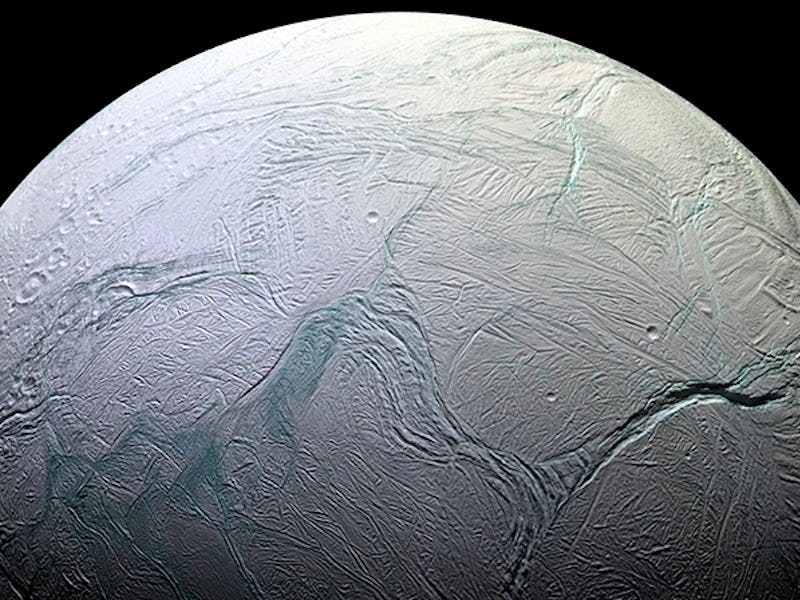Scientists uncover the strange tale of how Enceladus got its stripes
The crevices of Saturn's icy moon are named after 1,001 Arabian Nights, and are just as romantic.

The tale “Ali the Cairene and the Haunted House in Baghdad,” one of the many that make up 1,001 Arabian Nights, tells the story of a man drawn to the danger and mystery of a haunted house. Ali, the main character, is lured in by the fables of the house, and decides to spend the night in it for further exploration. His hunch pays off — he ultimately ends up being showered by a treasure of gold.
Much like the haunted house in this ancient tale, scientists have been intrigued by Saturn’s moon Enceladus for years. Although rather small in size, (it is compact enough to fit within the length of the United Kingdom,) the moon holds an ocean of liquid salt water beneath its crust. This lunar ocean shoots out icy plumes at around 800 miles per hour, which extend hundreds of miles out into the wider cosmos.
But Enceladus’ strangest features are the series of fissures that erupt with this watery ice, forming what has come to be known as the moon’s ‘tiger stripes.’
These fissures are each named after a character or place from 1,001 Arabian Nights. The four most prominent ones are Baghdad, Cairo, Alexandria, and Damascus.
A new study uncovers the origin story of these crevices and how they formed in parallel, evenly-spaced lines on the moon’s surface.
A close-up view of the crevices that formed on the surface of Saturn's icy moon.
“These stripes are like nothing else known in our Solar System,” Doug Hemingway, a postdoctoral fellow at the Carnegie Institution for Science, and lead author of the study, said in a statement. “No other icy planets or moons have anything quite like them.”
The study provides more clues to the inner-workings of this mysterious, potentially habitable world. Researchers published the findings this week in the journal Nature Astronomy.
How Enceladus got it’s stripes
The fissures were first discovered by NASA’s Cassini mission in 2005 as the spacecraft explored Saturn and its moons. Since their discovery, scientists have been trying to figure out how these stripes, which exist only on the moon’s otherwise smooth surface, came to be.
They have some distinct characteristics: These tiger stripes run approximately 130 kilometers across, and are parallel and evenly spaced, with around 35 kilometers between each of them. And they seem to have formed only on Enceladus’ south pole.
One of the contributing factors to these odd markings is Enceladus’ equally odd orbit. The moon is at times close to its host planet, and at other times far away from it. This gravitational push-and-pull causes the moon to be deformed — and it is also the reason behind the heat that keeps the water beneath its surface from freezing over.
Saturn’s gravitational tug exerts greatest force on the moon’s poles, where the surface of ice is at its thinnest. When Enceladus is experiencing periods of cooling, water freezes over and the icy crust becomes thicker on the surface. As the pressure increases from the expanding body of water, it causes the crust to burst open and form these fissures, according to the new study.
The researchers believe that Baghdad — on the moon’s south pole — was the first to form, and as water erupted from this icy crevice, it resulted in the formation of new fissures on either side. As water continued to erupt from the cracks, more of these tiger stripes formed.
Although unusual, Enceladus is one of a few potential places in our Solar System that could support life. Scientists have long suspected that the tiny moon could be habitable due to its oceanic subsurface, which could host microbial life.
“Enceladus discoveries have changed the direction of planetary science,” Linda Spilker, Cassini project scientist at NASA’s Jet Propulsion Laboratory, said in a statement. “Multiple discoveries have increased our understanding of Enceladus, including the plume venting from its south pole; hydrocarbons in the plume; a global, salty ocean and hydrothermal vents on the seafloor. They all point to the possibility of a habitable ocean world well beyond Earth’s habitable zone.”